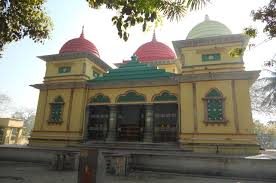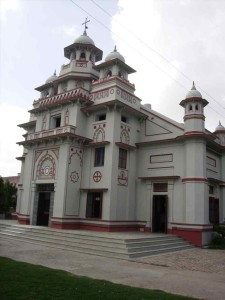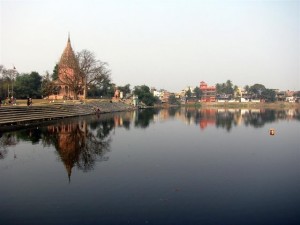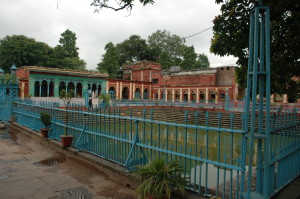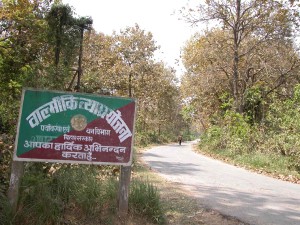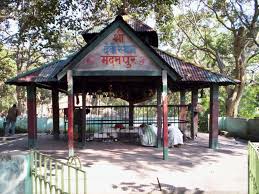West Champaran District was carved out of the old Champaran District in the year 1972 It was formerly a subdivision of Saran District and then Champaran District with its 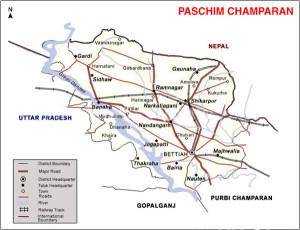 Headquarters as Bettiah. It is said that Bettiah got its name from Baint (Cane) plants commonly found in this district. The name Champaran is a degenerate form of Champaka aranya, a name which dates back to the time when the district was a tract of the forest of Champa (Magnolia) trees & was the abode of solitary ascetics.
Headquarters as Bettiah. It is said that Bettiah got its name from Baint (Cane) plants commonly found in this district. The name Champaran is a degenerate form of Champaka aranya, a name which dates back to the time when the district was a tract of the forest of Champa (Magnolia) trees & was the abode of solitary ascetics.
How To Reach
By Air (Airport):-
The nearest Airport is Gorakhpur Airport/GOP which is 112 KM’s from Bettiah railway station
By Rail :-
Bettiah comes under Samastipur Division in East Central Railways (ECR) Zone.
By Road :-
Well connected to other city through National Highway -28B 225 km from Patna State Highway – 54,64 and Other road – Bettiah Sewaghat Mainatard Rd,Lauria Ramnagar Road, 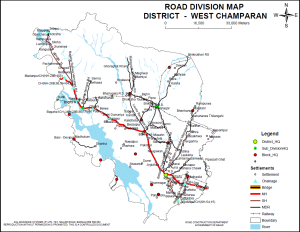 Bettiah Chanpatia Narkatiaganj Rd,Bagaha Semara Rd,Ramnagar Someshwar Rd, Majhawlia Jagdishpur Rd,Bagaha Sidhwa Harnatard Rd
Bettiah Chanpatia Narkatiaganj Rd,Bagaha Semara Rd,Ramnagar Someshwar Rd, Majhawlia Jagdishpur Rd,Bagaha Sidhwa Harnatard Rd
Bettiah is about 199 km from Patna
Popular tourist destinations
BETTIAH BLOCK
Circuit House :- It was, as late as 1920s, the European Club of Bettiah, where indigo planters from Champaran assembled for convivial weekends. The marble floors, the teak banisters, the wooden staircase and the sprung floors of the grand ball-room besides grand 16-seater teak dining table are cherished as monuments to gracious living.
Durga Bag:-
It has a historical temple of its kind which is well known for the myths and mysterious history because of which , it’s been an attraction for many saints for acquiring super natural power.
Anglican Church:-
It is situated near the district magistrate’s bungalow.w
Sant Ghat Temple :- A beautiful temple on the bank of Chandravat River. Beside these there are several other beautiful temple with legends associated with them.
Bajrang Bali Temple :-
Badi Masjid ,:- It is situated on one side of the Raj Deorhi.
This mosque, named Jangi Masjid, which is the tallest building of Bettiah
MJK College Pokhara :-
Uttarwari Pokhara :- This pond is situated in the northern part of Bettiah. It is a beautiful pond
Haribatika Pokhra :-
Shiv Mandir(Haribatika Pokhara ):-
Durga Badi Mandir :-
Balaji Temple:-
Shri Ram Sati Mandir
Shiva Mandir (Pioni Bagh , Imli chowk)
Shaheed Smarak(near town hall)
Bada Ramana :- It is open fields known as Bada Ramana. Bada Ramana also home to the football stadium known as “Maharaja Stadium” and an orphanage known as “Anathalaya”. It borders with a math known as “Santawan Das Math”.
Chota Ramana:- Chota Ramana is home to the city centre known as “Town Hall”. It is a venue for important meetings and functions. Chota Ramana borders with the “Saat Shaheed Sthal”(“The Seven Martyrs”) and the city library.
The ‘Raj Deorhi’ or the palace complex :-
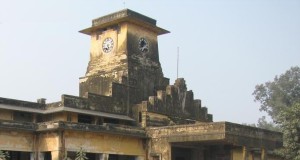 In 1910 at the request of Maharani, the palace was built after the plan of Graham’s palace in Calcutta. The Court of Wards is at present holding the property of Bettiah Raj.Though not much of the palace remains, the Raj Kutchery with a clock atop its tower still holds charm for any visitor.
In 1910 at the request of Maharani, the palace was built after the plan of Graham’s palace in Calcutta. The Court of Wards is at present holding the property of Bettiah Raj.Though not much of the palace remains, the Raj Kutchery with a clock atop its tower still holds charm for any visitor.
Shiva Temple(Raj Campus)
The Raj Museum:- Now a day it became government museum. It display and preserve the rich heritage of the regions.
Maharaja Pustakalay :- It is situated nearby Soa Babu Chowk. It was established in 1905. It was originally established as the Victoria Memorial Library and was renamed to Maharaja Harendra Kishore Public Library on Bettiah Raj last ruler Maharaja Sir Harendra Kishore Singh’s birthday in 1955. The library is established in an area of 1.45 acre and surrounded by boundary. It has four princely hall rooms comprising three depository rooms, one reading room, one office and one bathroom. There is a stage made in the east, which is used to host cultural functions and various other programs.
The Muhafiz Khana :- It is a treasure house of documents which would marvel any researcher. Like the Maharajas of Darbhanga, the Maharajas of Bettiah too possessed a record room or muhafiz khana. It is a rare repository.The Bettiah Raj muhafiz khana houses the official records pertaining to the administrative and legal affairs of the Raj for the past 250 years or so. The records are stored in two huge rooms having an approximate storage space of 40,000 and 72,000 cubic feet respectively.With a shelf space that is approximately half a kilometre in length, the Bettiah Raj muhafiz khana is indeed a rich repository of source materials for the study of the agrarian and political history not only of Bettiah, but of the wider region as well.The records are placed in bastas, which are individual bundles of records wrapped in cloth. These include rent registers and receipts, cash books, village notes and settlement records, village maps, legal proceedings and historical letters covering over 200 years of history.
St Mary’s cathedral (Roman Catholic church) :-Bettiah became home to Christians in mid-18th century with a the arrival of Nepali Newar Christians.It is established in year 1842. It is Catholic church.
The Bettiah Raj invited the Italian Capuchin priests to set up a mission here. Christian Quarters, a bustling Christian colony, is in the midst of the town, right beside the Raj Deorhi.
Sareya:- The KP Jayaswal Research Institute, during in the course of its Archaeological Explorations brought to light the site period Early medieval.
Saraiya Man :- It is situated at a distance of about 6 Kms. from Bettiah town. Saraiya man is a lake which is a beauty spot. The water of this lake is considered salubrious for digestion because of black berries (Jamun) planted on its banks which fall in the water. The lake attracts large varieties of birds.
Udaypur Wildlife Sanctuary:- It was established in 1978, and covers an area of 8.74 km².It is predominantly wetland, located on an oxbow lake the floodplain of the Gandaki River. It is home to a variety of water birds, both resident and migratory. The sanctuary has a rest house.
Shishawa:- The KP Jayaswal Research Institute, during in the course of its Archaeological Explorations brought to light the site period Early medieval. Barwat Sena:- The KP Jayaswal Research Institute, during in the course of its Archaeological Explorations brought to light the site period Early medieval
Sagar Pokhara:-
Sagar Pokhra is oldest Pond of the town and was made by Maharani Janki kunwar.A scenic pond with a marvelous temple around it. It is the centre of attraction of Chhath festival.
According to Jayaswal Research Institute Archaeological Explorations this site belongs to Medieval period.
Shiva temple and the Joda Shivalaya:-
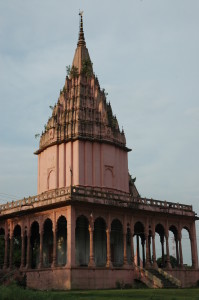
It is situated near the Sagar Pokhra with a majestic Shiva temple and the Joda Shivalaya, temples facing each other, with exquisite idols of Ganesh and Hanuman carved from a single piece ‘Moonga’ stone.
Kalibag:_
The KP Jayaswal Research Institute, during in the course of its Archaeological Explorations brought to light the site period Medieval
The Kalibag temple complex (Kalibag):-
It is an ancient temple founded by the Maharaja Harendra Kishore, the king of Bettiah Raj. It constitutes of a beautiful pond, a marriage hall, a community centre , an open field, garden. It is famous for 36 cr gods and goddess temple.The Maharaja had collected about 480 images of Hindu deities from all over India. He had installed them in this temple around a pond. Each and every image is duly worshipped even now by a large number of pujaries. Pilgrims can be spotted feeding fishes at this central pond.
According to Jayaswal Research Institute Archaeological Explorations this site belongs to Medieval period.
Roop Dih (A Tola):- The KP Jayaswal Research Institute, during in the course of its Archaeological Explorations brought to light the site period NBPW phase. Barwat Pasrain:- The KP Jayaswal Research Institute, during in the course of its Archaeological Explorations brought to light the site period Later Gupta. Sekhauna Dih:- The KP Jayaswal Research Institute, during in the course of its Archaeological Explorations brought to light the site period NBPW phase. Purani Ganauli Dih:- The KP Jayaswal Research Institute, during in the course of its Archaeological Explorations brought to light the site period Early medieval. Rani Pakari Dih:- The KP Jayaswal Research Institute, during in the course of its Archaeological Explorations brought to light the site period Early medieval. Ganauli Dih:-The KP Jayaswal Research Institute, during in the course of its Archaeological Explorations brought to light the site period Early medieval. Beldari:- The KP Jayaswal Research Institute, during in the course of its Archaeological Explorations brought to light the site period Kushana. Singachhapar Dih:- The KP Jayaswal Research Institute, during in the course of its Archaeological Explorations brought to light the site period Early medieval.
GAUNAHA BLOCK
Rampurwa:- The KP Jayaswal Research Institute, during in the course of its Archaeological Explorations brought to light the site period NBPW Phase.
(Rampurwa)Ashoka pillars :- Two Ashoka pillars (Two columns: a lion with Pillar Edicts I, II, III, IV, V, VI; a bull without inscriptions) with their capitals removed have been discovered in Rampurwa village, close to Gandhi’s Bhitiharwa Ashram in Gaunaha block. One of their capitals, the bull is now in the National Museum at New Delhi and the other, the lion, is at Calcutta Museum. 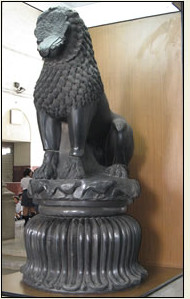 On the central part of the pillar is a well preserved inscription of Asoka containing all the well known six-pillar edicts of the emperor issued by him in the 26th year of his reign.
On the central part of the pillar is a well preserved inscription of Asoka containing all the well known six-pillar edicts of the emperor issued by him in the 26th year of his reign. 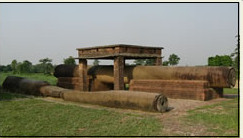 Five of the pillars of Ashoka (two at Rampurva, one each at Vaishali, Lauriya-Areraj and Lauriya-Nandangarh) were possibly marked the course of the ancient Royal highway from Patliputra to the Nepal valley.The pillars of Ashoka are a series of columns dispersed throughout the northern Indian subcontinent, erected or at least inscribed by the Mauryan king Ashoka during his reign in the 3rd century BCE. Originally, there must have been many pillars but only nineteen survive with inscriptions. Many are preserved in a fragmentary state. Averaging between forty and fifty feet in height, and weighing up to fifty tons each, all the pillars were quarried at Chunar, just south of Varanasi and dragged, sometimes hundreds of miles, to where they were erected.The uniformity of style in the pillar capital suggests that they were all sculpted by craftsmen from the same region. It would therefore seem that stone was transported from Mathura and Chunar to the various sites where the pillars have been found, and there was cut and carved by craftsmen. The pillars have four component parts. The shafts are always plain and smooth, circular in cross-section, slightly tapering upwards and always chiselled out of a single piece of stone. The capitals have the shape and appearance of a gently arched bell formed of lotus petals. The abaci are of two types: square and plain and circular and decorated and these are of different proportions. The crowning animals are either seated or standing, always in the round and chiseled as a single piece with the abaci.
Five of the pillars of Ashoka (two at Rampurva, one each at Vaishali, Lauriya-Areraj and Lauriya-Nandangarh) were possibly marked the course of the ancient Royal highway from Patliputra to the Nepal valley.The pillars of Ashoka are a series of columns dispersed throughout the northern Indian subcontinent, erected or at least inscribed by the Mauryan king Ashoka during his reign in the 3rd century BCE. Originally, there must have been many pillars but only nineteen survive with inscriptions. Many are preserved in a fragmentary state. Averaging between forty and fifty feet in height, and weighing up to fifty tons each, all the pillars were quarried at Chunar, just south of Varanasi and dragged, sometimes hundreds of miles, to where they were erected.The uniformity of style in the pillar capital suggests that they were all sculpted by craftsmen from the same region. It would therefore seem that stone was transported from Mathura and Chunar to the various sites where the pillars have been found, and there was cut and carved by craftsmen. The pillars have four component parts. The shafts are always plain and smooth, circular in cross-section, slightly tapering upwards and always chiselled out of a single piece of stone. The capitals have the shape and appearance of a gently arched bell formed of lotus petals. The abaci are of two types: square and plain and circular and decorated and these are of different proportions. The crowning animals are either seated or standing, always in the round and chiseled as a single piece with the abaci.
Bhitiharwa Ashram :-
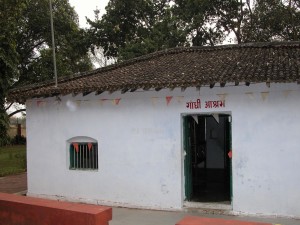 It is a village in Gaunaha block from where Gandhiji started his freedom movement that came to be known as ‘Champaran Satyagraha’ in India history. The village houses the hut which is called Ashram and has become a place
It is a village in Gaunaha block from where Gandhiji started his freedom movement that came to be known as ‘Champaran Satyagraha’ in India history. The village houses the hut which is called Ashram and has become a place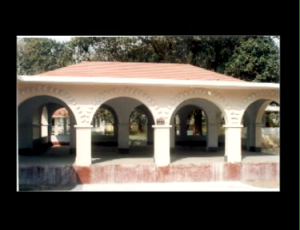 of Gandhian pilgrimage.Bettiah is also home to Mahatma Gandhi’s ‘Satyagraha’. In April of 1917, he camped at the Hazarimal Dharamshala here and toured the interiors of the district, meeting peasants and noting their complaints against the Indigo planters. At present there is a Khadi Centre working under direct control of the Bihar Khadi Samiti.
of Gandhian pilgrimage.Bettiah is also home to Mahatma Gandhi’s ‘Satyagraha’. In April of 1917, he camped at the Hazarimal Dharamshala here and toured the interiors of the district, meeting peasants and noting their complaints against the Indigo planters. At present there is a Khadi Centre working under direct control of the Bihar Khadi Samiti.
The Bhitiharwa Ashram originally known as the Kasturba Sewa Kendra, was inaugurated by Gandgiji in November 1917. Ashram is renovated in 2012, the Ashram’s walls have hunreds of framer achival photos of Gandhi’s visit, a School bell from those days andKasturba Gandhi’s Chakki.(Hand Mill).
Bhiknatohari :- It is beauty spot on the Sumeswer hill at a height about 600 ft located in Gaunaha block It is the last railway station on Narkatiaganj Bhiknathori section on the Nepal border. Located as it is on the edge of the forest in the Himalayan foothills, it gives a clear view of the snow capped Himalayas and the Annapurna peak in the winter. King George V had visited this place for hunting in year 1911. An attractive bungalow is still existent here.
Brindavan:- It is situated at a distance of 10 Km from Bettiah, in Gaunaha Block. This village had the honour of being the venue of the annual conference of ‘All India Gandhi Seva Sangh’ in 1937. It was attended by Mahatma Gandhi, Dr.Rajendra Prasad and Shri J.B. Kripalani. In 1938, during his second visit to Champaran, the Mahatma set up a cluster of Basic schools here.
Shri Rampur:- It is situated in the Gaunaha Block of Bhitiharwa Panchayat. Gandhiji had stayed here on 16th November, 1917.
Amolwa:- This village Gandhiji spent a night on the 27th April, 1917 with his other companions.
Kharkatwa Dih:- The KP Jayaswal Research Institute, during in the course of its Archaeological Explorations brought to light the site period Early medieval. Kamata Farm Dih:- The KP Jayaswal Research Institute, during in the course of its Archaeological Explorations brought to light the site period Early medieval. Dewarh:- The KP Jayaswal Research Institute, during in the course of its Archaeological Explorations brought to light the site period Gupta. Mahayogin (Hetu Kunwar):- The KP Jayaswal Research Institute, during in the course of its Archaeological Explorations brought to light the site period NBPW phase. Belwa:- The KP Jayaswal Research Institute, during in the course of its Archaeological Explorations brought to light the site period Early medieval. Belwa Mor Dih (Visa):- The KP Jayaswal Research Institute, during in the course of its Archaeological Explorations brought to light the site period NBPW phase. Saithawal (Near Madhopur Bairia):- The KP Jayaswal Research Institute, during in the course of its Archaeological Explorations brought to light the site period NBPW phase. Belwabahuwari:- The KP Jayaswal Research Institute, during in the course of its Archaeological Explorations brought to light the site period Chalcolithic. Pachgachhia:- The KP Jayaswal Research Institute, during in the course of its Archaeological Explorations brought to light the site period Early medieval.
RAMNAGAR BLOCK
Sumeswer Fort:- Fort is situated on the summit of the Someshwar hills, at a height of 2,884 feet above sea level, in Ramnagar block. The fort which stands on the edge of a sharp precipice, is now in ruins, but its remains are well defined and reservoirs cut out of the soild rocks, in which water was stored for the use of the inhabitants, can still be seen. From the ridge upon which Fort Sumeshwar is situated. a magnificent view of the snow and of the intervening valleys and low hills situated in Nepal can be seen . The ridge here forms the boundary between West Champaran and Nepal. The great Himalayan peaks of Dhoulagiri, Gosainthan and Gaurishanker are all clearly visible.
Harinagar:- It consists a modern temple look like a church with a steeple.
Sitapur Dih:- The KP Jayaswal Research Institute, during in the course of its Archaeological Explorations brought to light the site period Early medieval. Parasa Dih:- The KP Jayaswal Research Institute, during in the course of its Archaeological Explorations brought to light the site period Medieval. Ramnagar Thakurbari:- The KP Jayaswal Research Institute, during in the course of its Archaeological Explorations brought to light the site period Early medieval. Barawa Dih:- The KP Jayaswal Research Institute, during in the course of its Archaeological Explorations brought to light the site period Early medieval. Bargojwa Farm:- The KP Jayaswal Research Institute, during in the course of its Archaeological Explorations brought to light the site period Shunga. Sabeya (Muli Dih):- The KP Jayaswal Research Institute, during in the course of its Archaeological Explorations brought to light the site period Early medieval.
SIKTA BLOCK
Sargatia Chhatarwa:- The KP Jayaswal Research Institute, during in the course of its Archaeological Explorations brought to light the site period Gupta. Sargatia:- The KP Jayaswal Research Institute, during in the course of its Archaeological Explorations brought to light the site period NBPW phase. Arya Nagar:- The KP Jayaswal Research Institute, during in the course of its Archaeological Explorations brought to light the site period Early medieval. Puraina Dih:- The KP Jayaswal Research Institute, during in the course of its Archaeological Explorations brought to light the site period Kushan.Dumara:-The KP Jayaswal Research Institute, during in the course of its Archaeological Explorations brought to light the site period NBPW phase.
VALMIKI NAGAR BLOCK
Valmiki Nagar:-
The KP Jayaswal Research Institute, during in the course of its Archaeological Explorations brought to light the site period Early medieval
The Valmiki National Park :-
The Valmiki National Park (335 sq km) has been created amidst 544 sq km of the Valmiki Sanctuary in the West Champaran district, bordering Nepal. The magnificent Himalayas provide a backdrop to the sanctuary. Adjacent to the sanctuary, in the forests of Nepal, is the historic Valmiki Ashram in the Chitwan National Park of Nepal. The One-horned rhinoceros and Indian bison often migrate from Chitwan to Valmikinagar. The forest here is a mix of extensive Savannah lands and swamp forests. The forest in the sanctuary is rich in Bhabar-Dun sal, dry Siwalik sal, khair, cane etc. The extensive forest area of Valmikinagar was owned by the Bettiah Raj and Raman Nagar Raj until early 1950.
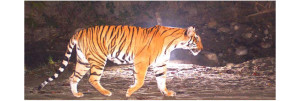 Tigers dominate the wildlife landscape while other attractions include chitals, sambars, nilgais, leopards, hyenas, Indian civets, Jungle cats, Hog deer and wild dogs. As far as the density of the tiger population is concerned, Valmikinagar ranks fourth in the state. Valmiki is the 18th Tiger Reserve of the country and the second in Biha. Eco-development activities were
Tigers dominate the wildlife landscape while other attractions include chitals, sambars, nilgais, leopards, hyenas, Indian civets, Jungle cats, Hog deer and wild dogs. As far as the density of the tiger population is concerned, Valmikinagar ranks fourth in the state. Valmiki is the 18th Tiger Reserve of the country and the second in Biha. Eco-development activities were  initiated in the Reserve in 1997-98. Activities such as distribution of fruit bearing plants, installation of hand pumps, construction of ponds, shed, irrigation channel were undertaken. Eco-awareness programmes were conducted. The inhabitants of some of the villages are coming forward voluntarily to assist forest staff in the protection of forest as well as in developmental activities.
initiated in the Reserve in 1997-98. Activities such as distribution of fruit bearing plants, installation of hand pumps, construction of ponds, shed, irrigation channel were undertaken. Eco-awareness programmes were conducted. The inhabitants of some of the villages are coming forward voluntarily to assist forest staff in the protection of forest as well as in developmental activities.
Devi Mandir (Madanpur):-
(Bhainsa Lotan)Valmiki Nagar :- This is a village on the Indo Nepal border 42 kms North-West of Bagaha . Formally known as Bhainsa Lotan. A barrage has been constructed here on the Gandak river for the purpose of irrigation. On the occasion of Makar Sankranti every year a fair is held on the bank of River Gandak.
Shiva temple :- It is constructed by the Bettiah Raj.
Nara Devi Temple:- It is ancient temple.
Gauri Shankar Temple:– It is ancient temple.
Triveni (Confluence Point ):- The confluence of river Gandak, Panchanand and Sonaha is situated about 8 km above the Valmikinagar Barrage. It is an attractive place to see. This place is at the Indo-Nepal border. One bank of this confluence touches Triveni village of Nepal while another bank extends to Bhaisalotan village of India. The holy book “Shri Mad Bhagwat” describes that the thousand years battle between Gaj (Elephant) and Grah (Crocodile) was started at this place. Lord Vishnu appeared and protected the elephant. Every year a fair is held at this holy place on the eve of “Magh Sankranti”.
BAGAHA BLOCK
Bawan Garhi :- Bawan Garhi name meaning 52 forts, given to the remains of some old fortifications near Darwabari in Bagaha block about 8 Kms from Tribeni. The place is also called Tripan Bazar . The remains of the 52 forts and 53 bazars are at a short distance to the north of the village. To the north-west across the swamp are remains of massive embankments which may perhaps have been intended to serve as reservoirs.
The villages of Chakhni:- Chakhni is important Christian missions in the district. The Christians from Bettiah have spread all over but they maintain links with their roots. Christmas time is for homecoming and the ‘Bada Din’ celebrations round up the festive season beginning with Durga puja in September-October. In between, Diwali and Chhath are also celebrated with great fervour.
Parasa:- The KP Jayaswal Research Institute, during in the course of its Archaeological Explorations brought to light the site period Early medieval. Bagaha:- The KP Jayaswal Research Institute, during in the course of its Archaeological Explorations brought to light the site period Medieval.
YOGAPATTI BLOCK
Bahuwarwa:- The KP Jayaswal Research Institute, during in the course of its Archaeological Explorations brought to light the site period Later Gupta. Gora:- The KP Jayaswal Research Institute, during in the course of its Archaeological Explorations brought to light the site period Chalcolithic. Govinapur:- The KP Jayaswal Research Institute, during in the course of its Archaeological Explorations brought to light the site period Early medieval.
NAUTAN BLOCK
Hardiya Kothi :- It is under Bishunpur Panchayat of the Nautan Block. It was house of Mr. G. P. Edward, a British Indigo Planter. Remains of this building are in somewhat better condition in comparison to other such old buildings. Loharpatti:-The KP Jayaswal Research Institute, during in the course of its Archaeological Explorations brought to light the site period Early medieval. Bishunpura Kakaria:- The KP Jayaswal Research Institute, during in the course of its Archaeological Explorations brought to light the site period NBPW phase. Diulia Dih:- The KP Jayaswal Research Institute, during in the course of its Archaeological Explorations brought to light the site period Early medieval. Khunjalhi Dih:- The KP Jayaswal Research Institute, during in the course of its Archaeological Explorations brought to light the site period Early medieval. Dhumnagar Dih:- The KP Jayaswal Research Institute, during in the course of its Archaeological Explorations brought to light the site period Early medieval. Jamunian Dih:- The KP Jayaswal Research Institute, during in the course of its Archaeological Explorations brought to light the site period Early medieval. Jagdishpur:- The KP Jayaswal Research Institute, during in the course of its Archaeological Explorations brought to light the site period Early medieval. Purana Dih:- The KP Jayaswal Research Institute, during in the course of its Archaeological Explorations brought to light the site period Early medieval. Majharia Kishun:- The KP Jayaswal Research Institute, during in the course of its Archaeological Explorations brought to light the site period Early medieval. Siorahi Mathia Dih:- The KP Jayaswal Research Institute, during in the course of its Archaeological Explorations brought to light the site period Early medieval. Diulia Belwa Tola (Noniar Dih):- The KP Jayaswal Research Institute, during in the course of its Archaeological Explorations brought to light the site period NBPW phase. Bahuwarva Dih:- The KP Jayaswal Research Institute, during in the course of its Archaeological Explorations brought to light the site periodEarly medieval.
CHANPATIA BLOCK
Brindaba :- It has the Gram Seva Kendra, which had been planned to work out the deals of the Gandhi Seva Sangh. The all India Gandhi Seva Sangh held there annual conference at this village in 1937. Mahatma Gandhi and Dr. Rajendra Prasad attended it. Gandhiji stayed here in 1939 and started an Ashram, which is still functioning.
Barwa Bari Dih:- The KP Jayaswal Research Institute, during in the course of its Archaeological Explorations brought to light the site period Early medieval. Patarrakha Dih:- The KP Jayaswal Research Institute, during in the course of its Archaeological Explorations brought to light the site period Early medieval. Turahapatti Dih:- The KP Jayaswal Research Institute, during in the course of its Archaeological Explorations brought to light the site period Early medieval. Kuria Kothi:- The KP Jayaswal Research Institute, during in the course of its Archaeological Explorations brought to light the site period Early medieval. Bhangaha Dih:- The KP Jayaswal Research Institute, during in the course of its Archaeological Explorations brought to light the site period Shunga. Siaro Sati Dih:- The KP Jayaswal Research Institute, during in the course of its Archaeological Explorations brought to light the site period NBPW phase. Bakulahar:- The KP Jayaswal Research Institute, during in the course of its Archaeological Explorations brought to light the site period Early medieval. Parukia Dih:- The KP Jayaswal Research Institute, during in the course of its Archaeological Explorations brought to light the site period Early medieval. Jabdaul:- The KP Jayaswal Research Institute, during in the course of its Archaeological Explorations brought to light the site period Early medieval. Bhangaha (Lohiaria):- The KP Jayaswal Research Institute, during in the course of its Archaeological Explorations brought to light the site period Early medieval. Lagunaha:- The KP Jayaswal Research Institute, during in the course of its Archaeological Explorations brought to light the site period Early medieval. Mushehari Dih:- The KP Jayaswal Research Institute, during in the course of its Archaeological Explorations brought to light the site period Early medieval. Barawan Chap Dih:- The KP Jayaswal Research Institute, during in the course of its Archaeological Explorations brought to light the site period Shunga-Kushana. Navaganwa Dih:- The KP Jayaswal Research Institute, during in the course of its Archaeological Explorations brought to light the site period Early medieval. Kabileshwar Dih:- The KP Jayaswal Research Institute, during in the course of its Archaeological Explorations brought to light the site period Early medieval. Chanpatia (Nageshwar Dham):- The KP Jayaswal Research Institute, during in the course of its Archaeological Explorations brought to light the site period Medieval. Khardeur Babu Tola:- The KP Jayaswal Research Institute, during in the course of its Archaeological Explorations brought to light the site period Gupta. Ghogha Pat Bandi Dih:– The KP Jayaswal Research Institute, during in the course of its Archaeological Explorations brought to light the site periodNBPW phase. Upadhyay Tola Dih:– The KP Jayaswal Research Institute, during in the course of its Archaeological Explorations brought to light the site period Early medieval. Parsauna Sareh:- The KP Jayaswal Research Institute, during in the course of its Archaeological Explorations brought to light the site period Early medieval. Gurwalia:- The KP Jayaswal Research Institute, during in the course of its Archaeological Explorations brought to light the site period NBPW phase. Jayantia Dih:- The KP Jayaswal Research Institute, during in the course of its Archaeological Explorations brought to light the site period Gupta. Lohiaria Kothi Dih:- The KP Jayaswal Research Institute, during in the course of its Archaeological Explorations brought to light the site period Early medieval. Jokahan:- The KP Jayaswal Research Institute, during in the course of its Archaeological Explorations brought to light the site period Early medieval. Ghogha Mishari Tola:- The KP Jayaswal Research Institute, during in the course of its Archaeological Explorations brought to light the site period Chalcolithic. Motichhapar Dih:- The KP Jayaswal Research Institute, during in the course of its Archaeological Explorations brought to light the site period Gupta. Belwa:- The KP Jayaswal Research Institute, during in the course of its Archaeological Explorations brought to light the site period Early medieval. Ekrahiya Babu Pokharia:- The KP Jayaswal Research Institute, during in the course of its Archaeological Explorations brought to light the site period Early medieval. Guruwalia Beldar:- The KP Jayaswal Research Institute, during in the course of its Archaeological Explorations brought to light the site period Early medieval. Sabeya Khurd:- The KP Jayaswal Research Institute, during in the course of its Archaeological Explorations brought to light the site period NBPW phase. Khairtia Dih:- The KP Jayaswal Research Institute, during in the course of its Archaeological Explorations brought to light the site period NBPW phase. Banipatti:- The KP Jayaswal Research Institute, during in the course of its Archaeological Explorations brought to light the site period NBPW phase. Bhainsahi:- The KP Jayaswal Research Institute, during in the course of its Archaeological Explorations brought to light the site period Early medieval. Navganwa:- The KP Jayaswal Research Institute, during in the course of its Archaeological Explorations brought to light the site period Early medieval. Tirhutia:- The KP Jayaswal Research Institute, during in the course of its Archaeological Explorations brought to light the site period Kushana. Awaraiya Dih:- The KP Jayaswal Research Institute, during in the course of its Archaeological Explorations brought to light the site period Later Gupta. Sirisia Mahadev:- The KP Jayaswal Research Institute, during in the course of its Archaeological Explorations brought to light the site period Early medieval. Chuhari:- The KP Jayaswal Research Institute, during in the course of its Archaeological Explorations brought to light the site period Early medieval.
NARKATIAGANJ BLOCK
Banwaria:- The Village is famous for its Shiva Temple situated between two tanks It is located about 9 km of Narkatiaganj. Every year fairs are held at this holy place in the month of Phalgun and Baisakh and large variety of wooden furniture and fixtures put on sale.
Binwalia:- The KP Jayaswal Research Institute, during in the course of its Archaeological Explorations brought to light the site period Early medieval. Mahuwa:- The KP Jayaswal Research Institute, during in the course of its Archaeological Explorations brought to light the site period Chalcolithic. Bisunpurwa:- The KP Jayaswal Research Institute, during in the course of its Archaeological Explorations brought to light the site period NBPW phase.
Chankigarh (Ruined fortress):- This village is situated about 9 km east of Ramnagar railway station. There is a large mound in the eastern part of the village. It is a mass of solid brickwork and is 90′ high. It was probably originally a fort and the remains of the fortification can still be seen, besides some insignificant shrines.The local tradition asserts that it was a Fort of king Janak . Another tradition says that it is the palace of Chanakya, the world famous economist.
According to Jayaswal Research Institute Archaeological Explorations this site belongs to NBPW phase period.
Garuraha Siman:- The KP Jayaswal Research Institute, during in the course of its Archaeological Explorations brought to light the site period Early medieval. Madhubani Dih:- The KP Jayaswal Research Institute, during in the course of its Archaeological Explorations brought to light the site period Gupta. Situapur:- The KP Jayaswal Research Institute, during in the course of its Archaeological Explorations brought to light the site period Early medieval. Tutuhia Dih:- The KP Jayaswal Research Institute, during in the course of its Archaeological Explorations brought to light the site period Early medieval. Khaptola Poina:- The KP Jayaswal Research Institute, during in the course of its Archaeological Explorations brought to light the site period Gupta. Garuanighat Dih:- The KP Jayaswal Research Institute, during in the course of its Archaeological Explorations brought to light the site period NBPW phase. Tedhi kunan Dih:- The KP Jayaswal Research Institute, during in the course of its Archaeological Explorations brought to light the site period NBPW phase.
MAJHAULIA BLOCK
Sariswa :- This place is in Ratanmala Panchayat under Majhaulia Block.Gandhiji and his companions had taken statement of raiyats in a open yard in front of the temple. Agarwa Dih:- The KP Jayaswal Research Institute, during in the course of its Archaeological Explorations brought to light the site period NBPW phase. Khutiaindu:- The KP Jayaswal Research Institute, during in the course of its Archaeological Explorations brought to light the site period Early medieval. Majhaulia:- The KP Jayaswal Research Institute, during in the course of its Archaeological Explorations brought to light the site period Early medieval. Ratanmala:- The KP Jayaswal Research Institute, during in the course of its Archaeological Explorations brought to light the site period NBPW phase. Dhokarahan:– The KP Jayaswal Research Institute, during in the course of its Archaeological Explorations brought to light the site period Early medieval. Mohiuddinpur:-The KP Jayaswal Research Institute, during in the course of its Archaeological Explorations brought to light the site period Gupta. Bhatawalia:-The KP Jayaswal Research Institute, during in the course of its Archaeological Explorations brought to light the site period Later Gupta. Mirzapur:- The KP Jayaswal Research Institute, during in the course of its Archaeological Explorations brought to light the site period Early medieval. Shikarpur:- The KP Jayaswal Research Institute, during in the course of its Archaeological Explorations brought to light the site period Kushana. Bishambharpur:- The KP Jayaswal Research Institute, during in the course of its Archaeological Explorations brought to light the site period Kushana. Khuntia Dih:- The KP Jayaswal Research Institute, during in the course of its Archaeological Explorations brought to light the site period NBPW phase. Dudha Chaturi Briti:- The KP Jayaswal Research Institute, during in the course of its Archaeological Explorations brought to light the site period Gupta. Mahanagani Dih:- The KP Jayaswal Research Institute, during in the course of its Archaeological Explorations brought to light the site period Early medieval. Nanosati:- The KP Jayaswal Research Institute, during in the course of its Archaeological Explorations brought to light the site period Early medieval. Chanayan Bandh:- The KP Jayaswal Research Institute, during in the course of its Archaeological Explorations brought to light the site period Early medieval. Binwalia:- The KP Jayaswal Research Institute, during in the course of its Archaeological Explorations brought to light the site period Early medieval. Khairwa:-_The KP Jayaswal Research Institute, during in the course of its Archaeological Explorations brought to light the site period Early medieval. Chailabhar Dih:- The KP Jayaswal Research Institute, during in the course of its Archaeological Explorations brought to light the site period Early medieval. Chaita Dih:- The KP Jayaswal Research Institute, during in the course of its Archaeological Explorations brought to light the site period Early medieval. Dhokrahan:- The KP Jayaswal Research Institute, during in the course of its Archaeological Explorations brought to light the site period Early medieval.
LAURIYA BLOCK
Lauriya:- The KP Jayaswal Research Institute, during in the course of its Archaeological Explorations brought to light the site period NBPW Phase.
Ashoka pillar (Lauriya-Nandangarh) :-
About one kilometer east of Nandangarh in Lauria block is the lion pillar of Ashoka with a single lion capital in excellent condition. It is a single block of polished sandstone, 32′-9.5″ in height with a diameter of 35.5″ at the base and 26.2″ at the top surmounted by the lion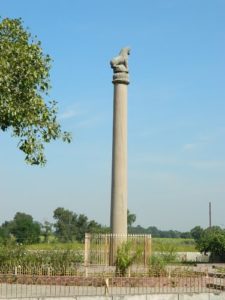 capital 6′ 10″ in height, adorned with the famous ‘Mauryan’ polish. The lion is represented with mouth wide open and the tongue protruding. As compared to other Asokan pillars, this one is much more slender and elegant in appearance.
capital 6′ 10″ in height, adorned with the famous ‘Mauryan’ polish. The lion is represented with mouth wide open and the tongue protruding. As compared to other Asokan pillars, this one is much more slender and elegant in appearance.
The following inscriptions have been observed to exist on the pillar:
i. The first six pillar edicts of Asoka, corresponding letter for letter to those on the Araraj pillar.
ii. A Persian inscription dated A.H. 1071 (A.D. 1660-61) engraved on the south face of the pillar. It refers to Emperor Aurangzeb and seems to have been engraved by some zealous follower of Mir Jumla’s army, who could have perhaps been responsible for the canon shot mark on the top of the shaft.
iii. A Nagari inscription dated Vikrama Sena 1566 (A.D. 1509)
iv. A Nagari inscription without date, but referring to King Amar Simha, son of King Narayana of Ujjain and to Maha Simha, son of Chhatiapati of Ujjain.
v. An English inscription recording the name of Rn. Barrow and dated 1792.
Stupa (Nandangarh ):- It is situated in Lauria block about 2 km, from the Asokan Pillar big mounds (Vedic burial mounds) which are the remains of palaces of Nanda Dynasty. At one end of the site was excavated a big stupa built of bricks and is about 80 feet high and consists of a series of terraces, raised one above the other, numbering five in all. On three of the terraces there is a passage for circumambulation. Nandangarh has also been conjectured as the ashes Stupa where the ashes of Buddha are said to have been enshrined.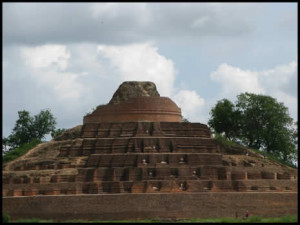
The numerous antiquities found in the excavations include many terracotta figures, pottery vessels of various types, stone beads, coins, metal objects like knives, Celts, daggers, arrow-heads, inscribed terracotta sealings, stone beads and other objects. The coins found here included a copper karshapana, a few copper cast coins one silver punch marked coins, a few round copper coins bearing legends in early Brahmi of about 1st century B.C.
Burial Mounds or Stupas:- It is situated besides an inscribed Asokan Pillar. There are fifteen stupa-mounds.To the south and west of the pillar are three rows of mounds, about five in each row, two of the rows running north to south, almost parallel to each other, while the third row runs east to west close to the pillar. In their configuration they are almost alike, somewhat conical in shape, though differing in size and height, the highest being about 50 feet in height. It is said that it was the fortified residences of the local ministers and nobles of Raja Uttanpat, one of the primeval kings of the Puranic tradition. Cunningham was the first to notice their antiquity and archaeological significance. He called them earthen barrows, representing the sepulchral mounds, belonging to some royal personage of primitive times.He did a trial excavation on the top of the mound, south-east of the pillar and discovered traces of a circular foundation wall formed of single bricks.On the recommendation of Cunningham another excavation was made in 1868-69. Excavation exposed a variety of items including pieces of bone, charcoal ashes and bits of crude pottery etc and came to the conclusion that the stupa here may represent a family or community funerary monument.
Out of 15 stupa-mounds , four of them were excavated in 1904-07 and as two of them yielded a put down of burnt bones with charcoal and a gold leaf with a mother-goddess shape (akin to the one from Piprahwa), they were regarded by the excavator to be vedic burial tumuli.As an answer of their re-examination in 1935-37, they were definitely accepted to be stupas of mud or mud-bricks with baked-brick revetments (in two cases with actual brick-lining). They were regarded as roughly current with the Piprahwa Stupa on account of the analogous find of the mother-goddess shape on the gold leaf.
Mishra Tola:-_The KP Jayaswal Research Institute, during in the course of its Archaeological Explorations brought to light the site period NBPW phase. Dhobani:- The KP Jayaswal Research Institute, during in the course of its Archaeological Explorations brought to light the site period Chalcolithic. Parsa Dhang Toli:- The KP Jayaswal Research Institute, during in the course of its Archaeological Explorations brought to light the site period NBPW phase. Jiria:- The KP Jayaswal Research Institute, during in the course of its Archaeological Explorations brought to light the site period Early medieval. Basantpur:- The KP Jayaswal Research Institute, during in the course of its Archaeological Explorations brought to light the site period Shunga. Baswaria Dih:- The KP Jayaswal Research Institute, during in the course of its Archaeological Explorations brought to light the site period Gupta. Biaspur:- The KP Jayaswal Research Institute, during in the course of its Archaeological Explorations brought to light the site period Later Gupta. Bankatwa:- The KP Jayaswal Research Institute, during in the course of its Archaeological Explorations brought to light the site period Early medieval. Bherihari Tola:- The KP Jayaswal Research Institute, during in the course of its Archaeological Explorations brought to light the site period Early medieval. Chhardawali Dih:- The KP Jayaswal Research Institute, during in the course of its Archaeological Explorations brought to light the site period Kushan. Biaspur Malahi Tola (Lipni Dih):- The KP Jayaswal Research Institute, during in the course of its Archaeological Explorations brought to light the site period Gupta. Parsa Mathia:- The KP Jayaswal Research Institute, during in the course of its Archaeological Explorations brought to light the site period Kushan.
